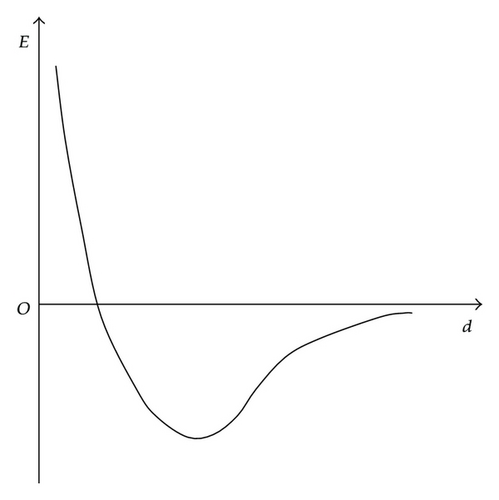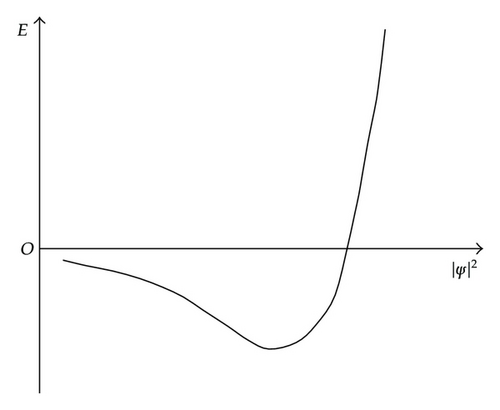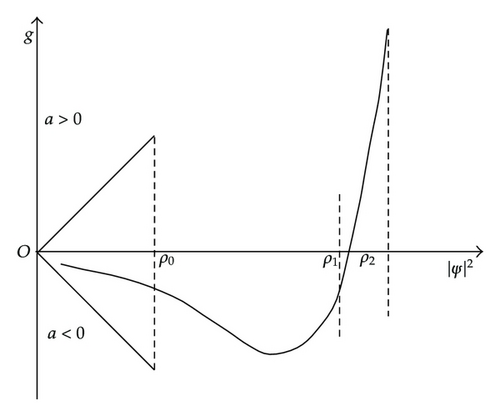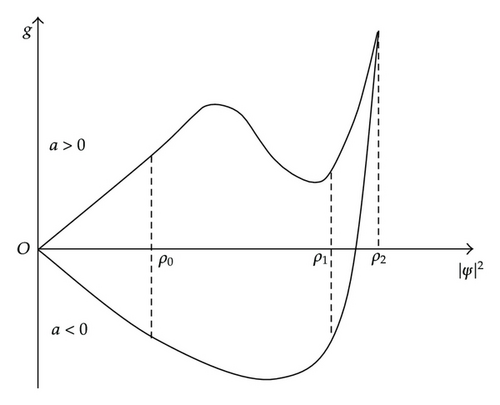A Nonlinear Schrödinger Model for Many-Particle Quantum Systems
Abstract
Considering both effects of the s-wave scattering and the atom-atom interaction rather than only the effect of the s-wave scattering, we establish a nonlinear Schrödinger model for many-particle quantum systems and we prove the global existence of a solution to the model and obtain the expression of the solution. Furthermore, we show that the Hamilton energy and the total particle number both are conservative quantities.
1. Introduction
As the fundamental equations in quantum mechanics, nonlinear Schrödinger (NLS) equations are usually chosen as models to describe many different kinds of many-particle quantum systems. One of the most typical examples is the Gross-Pitaevskii (GP) equation [1, 2] which was derived from a mean field approximation and used to describe the Bose-Einstein condensates (BEC) [3–7] for trapped dilute-gas at zero temperature.
GP-equation has been extensively studied during the past decades [8–12]. Numerical analyses have been applied to GP-equation to investigate the dynamics of BEC [8, 9]; analytical methods have also been used for solving the GP-equation to predict properties of the condensates [10], and rigorous mathematical proof has been provided to guarantee the existence of travelling wave solutions to the GP-equation [11, 12].
Apart from these studies, work related with utilizing the generalized GP-equation to investigate physical phenomena still attracts much attention [13–16]. Coste [13] derived a generalized GP-equation from the correction for the Lagrangian of the original GP-model and this model can describe both the two-fluid model and the Hills-Roberts model under two circumstances. By particle-number-conserving Bogoliubov method, Gardiner [14] demonstrated the validity of the time-dependent GP-equation for a highly condensed Bose gas. And with an equivalent method, Castin and Dum [15] obtained a generalized GP-equation which can yield both the time-dependent GP-equation for the condensate wave function and the linear dynamics of noncondensed particles in two situations. Furthermore, building on the works of Gardiner [14] and Castin and Dum [15], Gardiner and Morgan [16] derived a generalized GP-equation which can describe the condensate and noncondensate dynamics of Bose-Einstein dilute atomic gas at finite temperature.
Similarly, in this paper, we also acquire a generalized GP-equation. In the following we will outline the aim of this work.
It is well known that GP-equation has a wide range of validity provided that the scattering length (denoted by a) is much smaller than the average distance between particles (denoted by d). In the repulsive case [3, 4], from the physics point of view, the atom-atom interaction is effectively weak and dominated by the s-wave scattering, so the realistic interaction between particles can be well approximated by the s-wave scattering [17]. On the other hand, from the mathematics point of view, the solution to GP-equation is well defined in the repulsive case (i.e., a > 0) since there exists only one global solution to GP-equation; see [18–24] for more detail.
However, GP-equation is not consistent very well with the attractive case [4]. For the attractive case (i.e., a < 0), blow-up (collapse) may take place in the 2D and 3D cases, see [25–30]. In fact, as the temperature approaches to zero, the kinetic energy be small, which implies that blow-up deduced mathematically from GP-equation never happens in the experiments. Therefore, GP-model is not a correct model for describing the attractive case since it violates the compatibility of physical fact and mathematical result. To give a reasonable model which is compatible with physical fact and mathematical result is one of the motivations for this manuscript.
And to give a model which includes both effects of the s-wave scattering and the atom-atom interaction to describe more general many-particle quantum system near zero temperature is another motivation for this manuscript. It is noted that the atom-atom interaction can not be neglected when the scattering length is not much smaller than the average distance between particles. In this situation, GP-equation is not a good model to describe general many-particle quantum system.
In this paper, we establish an NLS model for more general many-particle quantum systems. Different from the interactions considering in GP-equation, the interactions among particles in the NLS model include both the s-wave scattering and the atom-atom interaction. And we will see later (Theorem 3.1) that there exists a global solution for the NLS model and no blow-up takes place. Furthermore, we will show that the NLS model can be regarded as a generalization of GP-equation. In the end, we prove that the Hamilton energy and the total particle number both are conservative quantities.
This paper is organized as follows. Section 2 derives the new Hamilton energy from the correction of the original one and obtains the NLS model. Section 3 proves rigorously the global existence of solution to the model and obtains the expression of the solution. Section 4 verifies that the conservation laws hold true. Section 5 discusses some existing approaches and compares them with ours. And Section 6 is devoted to the conclusions.
2. The NLS Model for Many-Particle Quantum Systems
In order to obtain the NLS model, we take two steps. At first, we derive the new Hamilton energy from the correction of the original one. And then the NLS model can be obtained by applying the theory of quantum physics to the Hamiltonian.
For the NLS model, the interaction potential energy is built on the basis of the wave-particle duality in quantum mechanics, the assumptions that the atom-atom interaction be chosen to be the van der Waals force [31, 32], and the interaction potential energy is changed continuously with density of particles.
The wave-particle duality in quantum mechanics points out that the many-particle quantum system has both the properties of wave and particle, which implies that the interactions among particles include both of the s-wave scattering and the atom-atom interaction. The interaction mechanisms of the former are the same as wave but the mechanisms of the latter are the same as particle. More precisely, if the scattering length is much smaller than the average distance between particles (i.e., a ≪ d), the s-wave scattering takes the leading role, and if the scattering length is much bigger than the average distance between particles (i.e., a ≫ d), the atom-atom interaction plays dominant role, or else the two both work.
If the scattering length is much bigger than the average distance between particles (i.e., a ≫ d), the atom-atom interaction is chosen to be the van der Waals interaction, see [31, 32] and the references therein and the relationship between the atom-atom interaction potential energy and the average distance between particles can be depicted as shown in the Figure 1.


Combining relationship (2.9) with Figure 2, we can get the effects of the s-wave scattering and the van der Waals interaction as shown in the Figure 3; (0, ρ0) is the domain in which the s-wave scattering takes the leading role, (ρ1, ρ2) is the domain in which the van der Waals force plays the dominant role, and (ρ0, ρ1) is the domain in which the two both work.

Considering both effects of the s-wave scattering and the van der Waals interaction and the assumption that the interaction potential energy is changed continuously with density of particles, we take function g as shown in the Figure 4.

Since |ψ|2 < ρ0 implies that the gas is dilute, the atom-atom interaction is effectively weak and the realistic interaction between particles can be approximated by the s-wave scattering. Under this condition and taking c0 = 2πaℏ2/m in (2.19), the NLS model (2.19) yields the GP-equation, which implies that (2.19) can be regarded as a generalization of the GP-equation.
3. Mathematical Results of the NLS Model
For the NLS model (2.19), we have the following global existence result.
Theorem 3.1. Assume that g satisfies conditions (2.15), (2.16) and (2.17), if V(x) ∈ L2(Ω), then for any ψ0 ∈ H1(Ω, C), there exists a global solution to (2.19) in C0([0, ∞), L2(Ω, C))∩L∞((0, ∞), H1(Ω, C)). Furthermore, for all (x, t) ∈ Ω × [0, ∞), the solution can be expressed as follows:
Proof. Firstly, we prove the global existence of solution to (2.19) in L∞((0, ∞), H1(Ω, C)) by Galerkin method.
Let ψ = u1 + iu2, by the theory of infinite dimensional Hamilton system proposed by Ma [24], (2.19) be equivalent to the following equations:
Let , X : = L2(Ω, R2) and choose as orthonormal basis of space L2(Ω).
Set Xn, as follows:
Consider the ordinary equations as follows:
By the theory of ordinary equations, there exists only one local solution of (3.6):
From (3.6) we can obtain the equality
Moreover, equality
Put into (3.10), we obtain that
Next, we claim that
Since (2.16) and (2.17) holds true; we have the following result:
If |ψ|2 > ρ3, by Poincaré’s inequality and Young’s inequality (3.13) holds true; on the other hand, if |ψ|2 ≤ ρ3, then ∫Ω (1/2h)g(|ψ|2) | ψ|2dx be bounded below, by Poincaré’s inequality and Young’s inequality (3.13) also holds true.
Since (3.12) and (3.13) hold true, then {(un, vn)} is bounded in L∞((0, ∞), X1). Therefore there exists a subsequence, we still write it as , such that
By (2.15), (2.16), and (2.17); and Rellich-Kondrachov Compactness Theorem, we know operator
Let n → ∞ in (3.8), following equality:
Since is dense in , equality (3.18) holds true for all , which implies that (u, v) ∈ L∞((0, ∞), X1) is a global solution of (3.3), then ψ = u + iv ∈ L∞((0, ∞), H1(Ω, C)) is a global solution of (2.19).
At last, we prove the global solution ψ = u + iv of (2.19) is in C0([0, ∞), L2(Ω, C)) by semigroup theory.
Set operator
Since the following equality:
The solution of (3.3) can be represented as follows:
By (2.15), (2.16), and (2.17); and Gagliardo-Nirenberg-Sobolev inequality, we obtain that the global solution of (3.3) satisfies (u, v) ∈ C0([0, ∞), X), which implies ψ = u + iv ∈ C0([0, ∞), L2(Ω, C)).
Furthermore, the solution ψ can be expressed as follows:
Remark 3.2. In [24], it was proved that all dynamic equations in quantum physics, that is,
4. The Conservation Laws
For the NLS model (2.19), we prove that the Hamilton energy and the total particle number both are conservative quantities.
Theorem 4.1. Assume that g satisfies conditions (2.15), (2.16) and (2.17), if V(x) ∈ L2(Ω), then for any ψ0 ∈ H1(Ω, C), there exist two conservative quantities for (2.19): the energy
5. Discussion
Taking the dense fluid of strongly interacting bosons as mixture of normal fluid and superfluid, and substituting the rule of Galilean invariance for local gauge invariance, Coste [13] made correction for the Lagrangian of the original GP-model by adding the degrees of freedom corresponding to the normal fluid. As a result, they obtained the generalized GP-equation which can describe both the two-fluid model and the Hills-Roberts model under two different circumstances.
Building on the works of Gardiner [14] and Castin and Dum [15], Gardiner and Morgan [16] derived the generalized GP-equation which can describe the condensate and noncondensate dynamics of Bose-Einstein dilute atomic gas at finite temperature. It is worthwhile to mention that unlike using expansion in inverse powers of the total number of particles in [14], Gardiner and Morgan [16] used expansion in powers of ration of noncondensate to condensate particle numbers and constructed the approximate Hamiltonian of third-order.
As the same as the above works [13, 16], the manuscript presented here also derive the generalized GP-equation from the correction of the original Hamiltonian. In addition, collapse (blow up) is prevented for our model and also for condensate and noncondensate dynamic model [16] when accounting for fluctuations.
But differences do exist. One of the differences is that the two above works are based on the classification of the state of particle (or the state of fluid), that is, condensate and noncondensate (or normal fluid and superfluid), but ours focus on the classification of interaction of particles, that is, the s-wave scattering and the atom-atom interaction. And another difference is the mechanism on which above related models build. The two-fluid model [13] respect Galilean invariance rule. The condensate and noncondensate dynamic model [16] obey the formalism of number-conserving. However, our model builds on the basis of the wave-particle duality in quantum mechanics.
It must be pointed out that our model is valid only on three assumptions. One is that the interactions among particles include only two effects: the s-wave scattering and the atom-atom interaction. Consequently, there is no other effect. Another one is that atom-atom interaction be chosen to be the van der Waals force. And the third one is that the interaction potential energy is changed continuously with density of particles.
Meanwhile, it is that the global solution to the NLS model is well defined and collapse (blow-up) is prevented guaranteeing the model is reasonable from the mathematical viewpoint, but further physical experiments should be done to verify this model. Especially, data from future experiments combining with the conditions (2.15) and (2.16) may give the exact expression of function g.
Inspired by the classification of the state of particle (i.e., condensate and noncondensate) in works [9, 10, 15, 16], and taking into account of the classification of the interaction of particles (i.e., the s-wave scattering and the atom-atom interaction), further investigation on the model of general many-particle quantum systems is necessary in future.
6. Conclusions
Building on the basis of the wave-particle duality in quantum mechanics and assumption that the interactions among particles include only two effects: the s-wave scattering and the atom-atom interaction, we derive the new Hamilton energy from the correction of the original one. From the new Hamiltonian we derive the NLS model for more general many-particle quantum systems. Expression of the global solution to the NLS model is obtained. Collapse (blow-up) is prevented for the model. Conservation laws hold true both for the Hamilton energy and the total particle number.
Acknowledgments
The authors are grateful to the anonymous referees whose careful reading of the paper and valuable comments were very helpful for revising and improving our work, as well as for bringing references [9, 16] to our attention. This work is supported by the Scientific Research Foundation of Civil Aviation Flight University of China (J2011-30).




